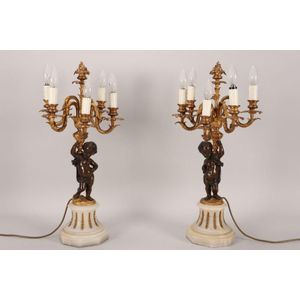French gilt bronze and onyx figural candelabra
Pair of late 19th century French gilt bronze and onyx figural candelabra, set with five acanthus scrolled branches and sconces, supported by putto, on waisted form pedestals with gilt wreath accents, above an octagonal base, height 70 cm (2)
You must be a subscriber, and be logged in to view price and dealer details.
Subscribe Now to view actual auction price for this item
When you subscribe, you have the option of setting the currency in which to display prices to $Au, $US, $NZ or Stg.
This item has been sold, and the description, image and price are for reference purposes only.
- Acanthus - A stylized leaf motif, one of the primary decorative elements of classical Greek and Roman architecture, derived from the genus of flowering plants in the family Acanthaceae, native to tropical and subtropical regions of the Mediterranean area. It is a common element in classical Greek and Roman design, and is often seen in Corinthian and Composite order columns and used as a decorative element in English, European and Australian furniture, particularly on the curve of a leg, and as decoration for a corbel.
- Bronze - An alloy of copper and tin, traditionally in the proportions of about 9 parts of copper to 1 part of tin.
The discovery of bronze in Western Asia in the 4th century enabled people to create metal objects which were superior to those previoulsy possible because of its strength and hardness, and it has been used throughout the world for weapons, coins, tools, statuary and other decorative items.
It is very fluid in a molten state, and its hardness, strength when set, and non-corrosive properties makes it most suitable for casting sculpture. - Sconce - A light attached to a wall. Originally a candle holder that is attached to a wall with an ornamental bracket and sometimes with a reflective back plate, but now applied to an electric light that has been inspired by that design.
In recent times the word has also come into use to desribe the candle holders on a candelabra. - Putto / Putti / Amorino / Amorini - A putto (plural: putti) or amerino (plural: amerini) is a cherub or cupid frequently appearing in both mythological and religious paintings and sculpture, especially of the Renaissance and Baroque periods and later used as a decorative element in the design of furniture, ceramics, statuary etc. They are usually depicted as chubby males, or of indeterminate gender, often with wings. Their depiction may represent an association with love, heaven, peace or prosperity.
- Onyx - Onyx is a form of agate, used from antiquity and popular again in the 1920s and 30s. European onyx is generally green, but can be many other colours, and can contain bands of black and/or white.
This multicoloured stone is widely used for table tops, lamp bases and in jewellery. Some types of onyx are also used for cameos of which the upper white layer is cut away to reveal the colour beneath.
This item has been included into following indexes:
-
candelabra / candelabrum
- French 163
- gilt and gold 178
- ormolu and bronze 191
- pairs and garnitures 519
- candlesticks, types - French 162
